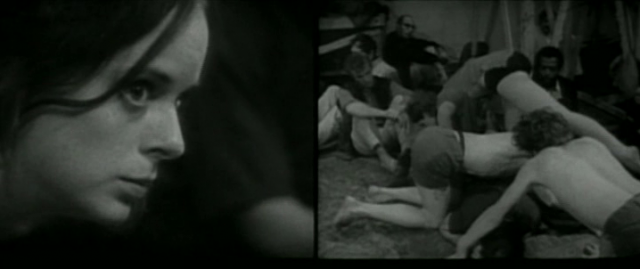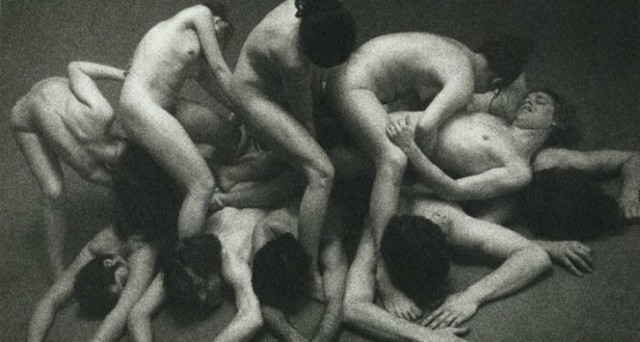
Brian De Palma uses split-screen technique to capture as much of DIONYSUS IN ’69 as he possibly can
DIONYSUS IN ’69 (Brian De Palma, Bruce Rubin, and Robert Fiore, 1970)
Metrograph
7 Ludlow St. between Canal & Hester Sts.
Sunday, June 5, 5:30
Series runs June 1-30
212-660-0312
metrograph.com
 Newark-born auteur Brian De Palma might be best known for such critical and popular successes as Scarface, Carrie, The Untouchables, Dressed to Kill, and Mission:Impossible, but he got his start as an underground indie filmmaker working in downtown Manhattan. One of his most intriguing pictures is the documentary Dionysus in ’69, screening June 5 in a monthlong retrospective at Metrograph that includes every De Palma movie save for his first, Murder a la Mod. In 1968, the Performance Group, led by Richard Schechner, staged Dionysus in ’69 in the Performing Garage on Wooster St., a participatory play based on William Arrowsmith’s translation of Euripides’ The Bacchae. The show was almost more of a happening than a drama, as the actors regularly disrobed (and at several points form a kind of sexual human centipede) and the audience, either sitting on the floor or up in wooden platforms with ladders, became part of the action. Dionysus in ’69 was the first example of Schechner’s Environmental Theater, a theory that posited, among other things: “1. The audience is in a living space and a living situation. Things may happen to and with them as well as ‘in front’ of them. 2. When a performer invites participation, he must be prepared to accept and deal with the spectator’s reactions. 3. Participation should not be gratuitous.” In a 1975 interview with David Bartholomew, De Palma explained, “I was very strongly affected by the play when I saw it. . . . This was the most exciting thing I’d seen on stage in years. So I began to try and figure out a way to capture it on film. I came up with the idea of split-screen, to be able to show the actual audience involvement, to trace the life of the audience and that of the play as they merge in and out of each other. I wanted to get the very stylized dramatic life of the play juxtaposed to what was really going on in that room at that time. I was floored by the emotional power of it.”
Newark-born auteur Brian De Palma might be best known for such critical and popular successes as Scarface, Carrie, The Untouchables, Dressed to Kill, and Mission:Impossible, but he got his start as an underground indie filmmaker working in downtown Manhattan. One of his most intriguing pictures is the documentary Dionysus in ’69, screening June 5 in a monthlong retrospective at Metrograph that includes every De Palma movie save for his first, Murder a la Mod. In 1968, the Performance Group, led by Richard Schechner, staged Dionysus in ’69 in the Performing Garage on Wooster St., a participatory play based on William Arrowsmith’s translation of Euripides’ The Bacchae. The show was almost more of a happening than a drama, as the actors regularly disrobed (and at several points form a kind of sexual human centipede) and the audience, either sitting on the floor or up in wooden platforms with ladders, became part of the action. Dionysus in ’69 was the first example of Schechner’s Environmental Theater, a theory that posited, among other things: “1. The audience is in a living space and a living situation. Things may happen to and with them as well as ‘in front’ of them. 2. When a performer invites participation, he must be prepared to accept and deal with the spectator’s reactions. 3. Participation should not be gratuitous.” In a 1975 interview with David Bartholomew, De Palma explained, “I was very strongly affected by the play when I saw it. . . . This was the most exciting thing I’d seen on stage in years. So I began to try and figure out a way to capture it on film. I came up with the idea of split-screen, to be able to show the actual audience involvement, to trace the life of the audience and that of the play as they merge in and out of each other. I wanted to get the very stylized dramatic life of the play juxtaposed to what was really going on in that room at that time. I was floored by the emotional power of it.”

The cast and the audience interact in unique ways in DIONYSUS IN ’69
De Palma and codirectors Bruce Rubin and Robert Fiore weave in and around the actors and the audience with handheld cameras that make viewers feel like they are right there in the midst of a wild and crazy orgiastic experience as Dionysus (William Finley, who appeared in eight of De Palma’s films) engages in verbal battles with Pentheus (Will Shepherd) over faith, the wrath of the gods, and ritualistic behavior, referring to each other by their real names as well as their characters’. The cast also includes Joan MacIntosh as Agave, Patrick McDermott as Tiresias, and Richard Dia as Cadmus. De Palma uses a split screen to show two angles of what is occurring in the garage at every moment, including occasionally getting glimpses of the cameramen themselves. De Palma would go on to use the split-screen technique in future works, and the theme of voyeurism would become one of his trademarks. In 2012, the Austin-based company Rude Mechs restaged the original Dionysus in ’69 at New York Live Arts, using De Palma’s film as a major source, but seeing the original event onscreen has a charm, and strangeness, all its own. “I always feel that even though the film didn’t make any money, it was something that should have been done. I think [Dionysus in ’69] will live long, long, after some of my other movies,” De Palma told Bartholomew. You can judge for yourself during the Metrograph series, which boasts such early, experimental flicks as Get to Know Your Rabbit, Greetings, and Hi, Mom! as well as many films that will live on much, much longer.